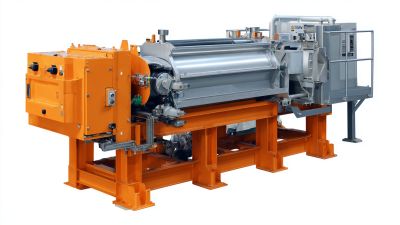 +86 13600513715
+86 13600513715



The wastewater treatment industry has witnessed significant advancements in filtration technologies, with Rotary Drum Filters emerging as a pivotal component in enhancing operational efficiency. These innovative systems are designed to effectively separate solid particles from liquids, achieving high levels of clarity in treated water. According to a report by the Global Water Intelligence, the market for advanced filtration technologies, including Rotary Drum Filters, is projected to grow at a CAGR of 5.2% from 2020 to 2027, driven by the increasing demand for clean water and stringent environmental regulations. Rotary Drum Filters utilize a rotating drum mesh to capture debris while allowing clear effluent to pass through, resulting in reduced operational costs and maintenance efforts. As municipalities and industries around the world strive for sustainable practices, understanding the efficiency and optimal application of Rotary Drum Filters in wastewater treatment systems is crucial for meeting future water quality standards and resource recovery goals.

Rotary drum filters (RDFs) are essential components in wastewater treatment systems, offering unique advantages in terms of efficiency and performance. To evaluate the effectiveness of these filters, specific efficiency metrics serve as key performance indicators (KPIs). These metrics include parameters such as filtration rate, solids removal efficiency, and operating costs, each providing insights into the overall functioning of the filtration system.
Filtration rate is a crucial KPI, indicating how quickly wastewater is processed through the rotary drum filter. High filtration rates signify effective performance, while a lower rate may suggest operational inefficiencies or clogging issues. Solids removal efficiency is another important metric, as it measures the percentage of suspended solids that the filter can effectively capture. This figure directly correlates to the quality of the treated effluent and the filter's ability to meet regulatory standards. Finally, monitoring operating costs, including energy consumption and maintenance expenses, helps gauge the economic viability of the rotary drum filter within the broader context of wastewater treatment operations. By analyzing these KPIs, operators can optimize the performance of rotary drum filters, ensuring sustainable and effective wastewater management.

Rotary drum filters have gained prominence in wastewater treatment systems, thanks to their high efficiency and versatility. When comparing rotary drum filters to other treatment solutions, such as membrane filtration or traditional sedimentation, the rotary drum design stands out for its ability to handle varying flow rates and solids concentrations effectively. This adaptability makes it particularly beneficial in industries where water quality requirements fluctuate.
Tips for Choosing Filtration Solutions: When evaluating filtration options, consider the specific needs of your treatment system, including capacity and type of contaminants. Rotary drum filters excel in applications requiring continuous operation and low maintenance, setting them apart from batch systems. Additionally, exploring recent advancements in filtration technology can further enhance your system's efficiency.
Another advantage of rotary drum filters is their ability to reduce energy consumption compared to other filtration methods. Innovations in design, such as the introduction of new filtration products, enhance their performance and reliability. By staying updated on the latest technologies, you can better assess how rotary drum filters can integrate into your wastewater treatment processes for optimal results.
When optimizing the performance and longevity of rotary drum filters (RDFs) in wastewater treatment systems, several operational tips can enhance efficiency. Regular maintenance is crucial; reports indicate that proper cleaning can boost filtration capacity by up to 20%. The accumulation of debris can significantly impede flow rates, so implementing a routine maintenance schedule is essential for preventing operational downtime. According to a study by the Water Environment Federation, well-maintained RDFs can achieve a solids removal efficiency exceeding 98%, underscoring the importance of consistent upkeep.
Additionally, the selection of optimal operating conditions greatly influences the performance of rotary drum filters. Maintaining the appropriate hydraulic loading rates—usually between 20 to 30 m³/m²·h—ensures optimal filtration without overwhelming the system. Adjusting the slope of the drum can also facilitate effective drainage, promoting better solids removal. A report by the International Journal of Environmental Research highlights that fine-tuning these parameters can extend the life of the filter by minimizing mechanical wear and tear, securing a reliable and efficient wastewater treatment process.
Proper maintenance of rotary drum filters is crucial for achieving optimal efficiency in wastewater treatment systems. Routine inspections, cleaning, and timely replacement of worn components are vital to prevent system downtime and ensure continuous operation. According to a recent report by the Water Environment Federation, regular maintenance can improve filter performance by up to 25%, significantly enhancing the overall treatment process. This underscores the importance of establishing a systematic maintenance schedule to monitor the condition of the drum filters.
Moreover, specific best practices can further enhance the longevity and efficiency of rotary drum filters. Keeping the filter surface clean and free of debris not only minimizes clogging but also maintains the desired flow rates. Industry surveys indicate that systems with well-maintained filters have 30% lower energy consumption compared to those with neglectful practices. Additionally, implementing advanced monitoring technologies can help operators identify inefficiencies early, allowing for proactive maintenance decisions, which can lead to average cost reductions of 15% in operational expenses. By adhering to these maintenance best practices, wastewater treatment facilities can ensure their rotary drum filters operate at peak efficiency, contributing to more sustainable and effective treatment outcomes.
| Maintenance Activity | Frequency | Importance Level | Impact on Efficiency |
|---|---|---|---|
| Cleaning of Drum Screens | Daily | High | Critical |
| Inspection of Bearings and Seals | Monthly | Medium | Moderate |
| Lubrication of Moving Parts | Bi-Weekly | High | Significant |
| Adjustment of Tension Settings | Quarterly | High | Important |
| Replacement of Worn Parts | As Needed | Very High | Critical |
| Cleaning of Filtered Solids Collection | Weekly | High | Significant |
 Rotary drum filters have demonstrated significant effectiveness in various wastewater treatment scenarios, showcasing their versatility and reliability. One notable case study involved a municipal wastewater treatment plant that faced increased inflow during heavy rainfall. By integrating rotary drum filters, the facility achieved a remarkable reduction in suspended solids, ensuring compliance with regulatory standards while maintaining operational efficiency. The continuous operation of these filters allowed for real-time adjustments based on flow variations, enhancing the overall treatment process during peak loads.
Rotary drum filters have demonstrated significant effectiveness in various wastewater treatment scenarios, showcasing their versatility and reliability. One notable case study involved a municipal wastewater treatment plant that faced increased inflow during heavy rainfall. By integrating rotary drum filters, the facility achieved a remarkable reduction in suspended solids, ensuring compliance with regulatory standards while maintaining operational efficiency. The continuous operation of these filters allowed for real-time adjustments based on flow variations, enhancing the overall treatment process during peak loads.
Another successful application was observed in an industrial setting, where a food processing company struggled with high organic loading in its wastewater. The installation of a rotary drum filter not only improved the quality of the effluent but also enabled the plant to recover valuable water, which could be reused in production. This dual benefit of treatment and resource recovery illustrates the filter's adaptability to different industrial challenges, making it an attractive option for many sectors looking to improve their wastewater management practices.






